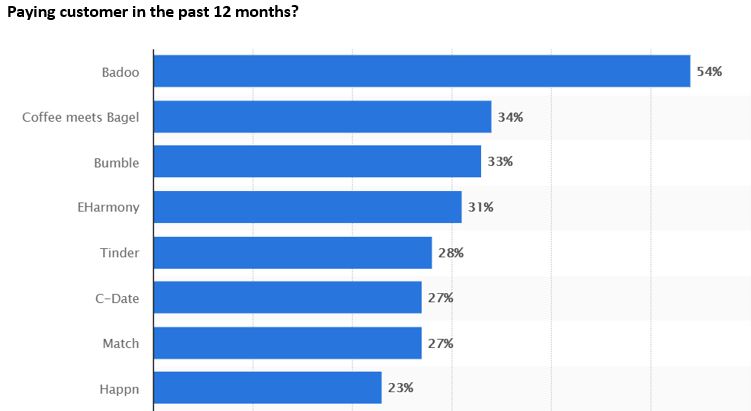How did a small player such as Coffee Meets Bagel manage to compete and win market share from a $3 billion market leader Tinder?

How did a small player such as Coffee Meets Bagel manage to compete and win market share from a $3 billion market leader Tinder?
Online dating is one of the most interesting platform business. Despite being around as a web-based business for a very long time, the business exploded in 2014 through an app-based program called “Tinder”. The dating app giant originated from inside Hatch Labs in 2012. By 2014, Tinder hit one of the most important milestones for the company. In spring of 2014 Tinder hits one billion matches. By summer of the same year, Tinder hits 2 billion matches. Today Tinder has $3 billion valuations with ~26% market share in the US.
Coffee Meets Bagel is an alternative dating app, a direct competitor to Tinder. The company has an aim to improve the quality of dating experience for female. Despite joining the online dating landscape only slightly after Tinder, the company has a drastically lower market share. Coffee Meets Bagel has 2.4% market share. The market share seems very gloomy for the company, however, the company is still doing well.
How did the company that seems to miss the first mover opportunity but still able to stay in the business?
There are three key factors that allow Coffee Meets Bagel to compete in the market.
First, the strong network effect nature of the industry helps Coffee Meets Bagel scale and maintain market share. The company differentiates itself by focusing on female user experience. All the male profiles shown to female already select the female. It is then up to the female to make the final decision whether to start the conversation. Bumble, the other startup also follow the same strategy. By appealing to female users, especially Asian, Coffee Meets Bagel was able to start the network effect. The company can then attract a lot of male users through strong networking effect nature of the industry. Furthermore, although the network effect is mostly local for ease of meeting up there is also a global network effect. If there is enough female user base the model will work anywhere in the world. For example, most recently in, Thailand the company was able to leverage international student and expatriates community to start the network effect.
Second, the industry has a high multi-homing effect. Because most of the applications use freemium model there is limited switching cost for the customer. Furthermore, it’s in all the user interested to meet as many people as possible to find their true soulmate. It is very common for users to install multiple dating apps at the same time. This allows for smaller players to stay in the game and maintain market share. In a way, the larger player with a high budget for advertising helps support the adoption rate for the smaller players with limited advertising capability.
Third, the company has one of the highest rates of paying customer. From a survey conducted by Statista, as high as ~34% of Coffee Meets Bagel users are paying to use the app. This is the second highest rate among top dating apps.
Although online dating competitive landscape is fierce, due to multi-homing effect it is also fragmented. Multi-homing effect couple with differentiation strategy from each player created the landscape. It would be interesting to see how each player reacts to the situation to try to win the market.
Sources:
https://techcrunch.com/gallery/a-brief-history-of-tinder/
https://www.statista.com/statistics/737081/popular-online-dating-market-share-users-monthly/





Great post! While I like that Coffee Meets Bagel focuses on improving the female’s user experience in order to increase their female user base, their decision to send a small number of potential matches to users each day reduces the time spent, and therefore the stickiness, of users to the app. If someone does not like their suggested “bagels” that day, they have to wait a full 24 hours before using the app again. In the meantime, they may swipe through Bumble’s unlimited potential suitors, increasing multi-homing and decreasing the need to log back on to Coffee Meets Bagel.
I think the online dating space is very interesting because as you say, people are looking for “true love”. However, if they find their true love through an app such as Coffee Meets Bagel, they will no longer be on the app, meaning they are not contributing to the overall network effect. Does this mean that Coffee Meets Bagel and other such apps don’t actually want customers to find true love and stay forever on their platform?
Really interesting look at the many, many dating apps that proliferate the market today. A few years ago, I felt that each of these different apps would in many ways be fads – many would come and go – but it seems that that may not be the case. I think looking at overall market share isn’t the most fair comparison across the apps since many, as you pointed out, target different parts of the population. I imagine we would see dramatically different market share pictures if we looked by age. I’d be curious to know as well how Coffee Meets Bagel (and Baddo) have been so much more successful than the others at converting free users into paying customers, since ultimately this will be a critical driver of profit and success for these platforms moving forward.
Another dating platform which shows the huge acumen of HBS students in the field ;). I remember watching their pitch at Shark-Tank. They were totally grilled by high valuation. However, founders were so confident about their platform and kept moving forward. I think existence of various sub-segments and demand for targeted matching results in fragmented market in dating app market. Main success of coffee and bagel comes from encouraging the positive feedback loop for real drivers of the platform who are women. As Tinder gets more trashy and casual, others are able to come up with serious dating propositions.